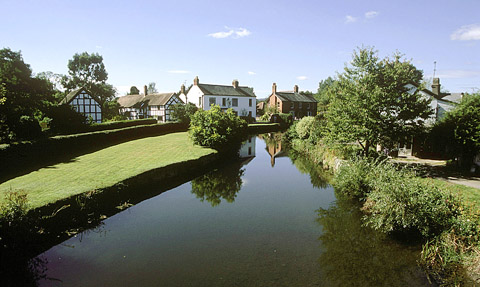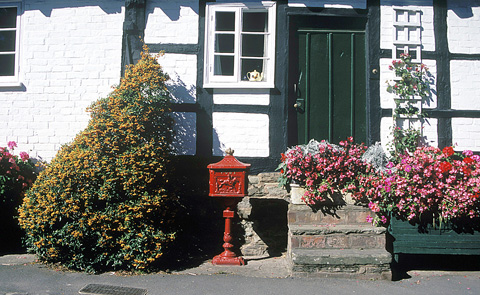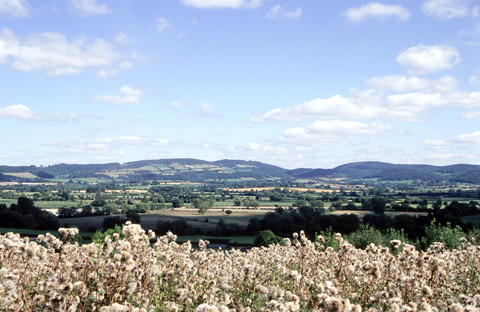If you’ve ever wondered even briefly about the raw sensation of power, how it might feel to hold the visible earth in your hand and close your fingers over it like a marble, there are worse places to stand than the topmost reaches of Wigmore Castle.
Behind you stretches high, rolling pastureland. Before your feet, field after field retreats into the distance: farmhouses, hedgerows, a river. If it were the early 1300s, and you were the bloody-minded aristocrat Roger de Mortimer, this would be your castle, and everything in view would be yours. Isabella, queen of England, would be your mistress. The farmers for kilometers around would labor under your thumb.
And if you’ve ever thought about what happened to that kind of temporal power, this is also a pretty good place to stand. Today the abandoned castle is a tangle of shrubs and trees, a roofless tumble of stone ruled by birds and preservation bureaucrats in an office somewhere else.

PHOTO: NY TIMES NEWS SERVICE
Today it is the farmers, not the barons, who preside over the hills of Herefordshire, a swath of west-central England nestled against the border with Wales. And what has happened under their watch in the past several years is an extraordinary thing. In a nation whose tourist appeal has long been its historical monuments — chilly gray medieval castles, the grand traces of men like De Mortimer — a new kind of history has intruded. It is the inns, the farms, the charming houses, and most remarkably the traditional food that is now the chief draw of Herefordshire, the living legacy not of the feudal lords, but of the generations of people who lived and died in their shadow.
Today Herefordshire may be one of rural Britain’s most interesting places to visit, and it is the farmers that make it so.
I had spent a lot of time in England in my life without ever visiting Herefordshire, but on my most recent trip I decided to go somewhere new. I rented a car at Heathrow Airport and drove west from London, no more than a few hours.

PHOTO: NY TIMES NEWS SERVICE
Because development never really swept over the county, Herefordshire today has not only a wealth of farmland but also perhaps the largest concentration of black-and-white half-timber houses in the UK. To encourage visitors, a 64km driving route was developed two decades ago, a trail of a dozen or so picturesque villages. To drive from one to another feels like passing through a back lot of Shakespearean stage sets.
On the northern end of Herefordshire is Wigmore, the hilltop village crowned by the ruins of De Mortimer’s castle. It’s a stop on another route, a linked set of hiking paths called the Mortimer Trail. That distinction has not exactly flooded Wigmore with tourism, however: Two weeks before I arrived, the town’s only store closed, leaving two pubs, a post office, and a garage as the local businesses. The owners of one of the pubs told me they were considering selling it.
I walked into the quiet church beneath the castle, St James, whose timbered ceiling is 600 years old and whose herringbone brickwork spoke of even deeper roots in Saxon England. There were no other visitors. Outside I met a man who said he had retired 26 years ago as principal of the local school, and who told me proudly that the land here was listed in the Domesday Book, the 11th-century register of English property. Of 140 burgages recorded at the time, he told me, more than 130 had been found outlined on the ground. I was impressed, I told him. (I felt like it might spoil the mood if I asked him what a burgage was.)

PHOTO: NY TIMES NEWS SERVICE
The road south from Wigmore Castle crosses the River Lugg, a shallow and pretty waterway. I turned off for Eardisland, another of the villages; as you drive into the town, the preserved houses peek at you like familiar but elusive birds: a flash of white panel here, a lattice pattern there. Some are lovingly maintained and stand out crisply against the fields and blue sky; some seem to be vanishing into the landscape. One was so thickly covered with ivy that I had to stop the car and walk around it just to convince myself there was a house there at all.
I spent an hour walking the quiet back lanes of the town, guided by a sweet hand-drawn map that I picked up at the church. The tower’s eight bells are a “favourite with touring teams of ringers,” it told me, and plaques around the bell ropes commemorated an astonishing number of bell-ringing marathons, captained chiefly by a man named Leslie Evans. I kept reading: Evans’ enthusiasm for bells eventually won him that most English of perks, an invitation to Buckingham Palace. One imagines his trip to London as the first quiet day in Eardisland in decades.
The most interesting thing in town, however, was neither the church nor a black-and-white house: It was a building marked “Pigeon Hse” on the map, which turned out to be an 18th-century dovecote. Inside the squat brick tower were lofty interior walls lined with tiny nooks. Here, in another age, people deliberately tried to create more pigeons! I stood entranced in this building where pairs of rock pigeons once roosted, cooed, laid eggs, and eventually provided the little town with countless squab dinners.
None of these villages was on the map I had brought from the US, but English road signs are very good, so I pointed my car down a long back road, slicing through thick leafy hedges to the next town, Pembridge.
This was much larger than the other towns, with a real main street, a large parish church, and a curious 13th-century bell tower whose layered, pagoda-like roof looked like nothing I had ever seen. A sign inside identified the style as Scandinavian. Another plaque noted that Evans, the apparently unstoppable bell-ringer of Eardisland, visited Pembridge to ring these bells in 1956.
It was at a shop in Pembridge that I began to get a sense of what makes Herefordshire distinct, beyond the bells and the quiet pretty villages. I was eating a sandwich of cheese and homemade chutney, made by a nearby kitchen called Sally’s Pantry. I was drinking a tart local apple juice. There were parsnip chips from a neighboring farm, local meat pies, local ice cream. In Wigmore, I had been offered cider and perry — an alcoholic pear drink — from a Herefordshire cider mill. I had been through farming regions before, but never seen so much of the local economy actually show up at my meals.
What has happened in Herefordshire feels like an extreme example of what has happened in the UK in the past several years. Partly from environmental hectoring, partly from fear of livestock disease, Britons have increasingly turned to locally farmed, locally produced food. The national palate has grown more sophisticated, too, and the result has been a kind of explosion of traditional British cooking — an increasingly compelling version of a cuisine that was an unappetizing punchline for generations.
I began to wonder, idly, if you could survive on nothing but food from Herefordshire. It turns out that I am not the only person to wonder this: A woman named Trish Marsh is currently trying to go an entire year eating only locally grown food. From her blog (herefoodshire.blogspot.com), it sounds very appealing at times — the county is known for its voluminous strawberry production, for instance — but a little parsnip-heavy in winter.
Herefordshire throws a food festival every year, and the most recent one attracted 8,000 people and 129 producers, a local official named Jane Lewis told me on the phone later. Ninety percent of the produce was from the county. “Not many food festivals can boast that,” she said. “Some places, they may have 25 cheese producers in their county, but then it’s more or less a cheese festival, isn’t it?”
At the Riverside Inn, where I was staying — a (yes) black-and-white building by a bridge over the Lugg — breakfast included one of the most extraordinary pieces of bacon I have ever seen, a long comma-shaped lobe with a meaty end and a fatty end, two kinds of meat all by itself. Dinner involved trout from a local stream, pork from a nearby pig (perhaps the same one that became the bacon) and salad grown on the hillside behind my room.
Food has become Herefordshire’s legacy, and you could say it has even taken over the county’s historical sites, not just metaphorically. Seven hundred years after the earl Roger de Mortimer was hanged for his presumption, his castle is a tumble of stone overrun by brambles, purple sloe, and tiny damsonberries. It was silent when I visited. I took off my sweater and basked in the unexpected English sun. There was one other person picking her way through the grassy trails, a young woman, maybe 22. I asked her what brought her here. History? The sweeping, almost crushingly pretty view?
“Blackberries,” she said, holding up a bag.
In the sun, amid the soft twitter of birds, centuries after the De Mortimer family died out and left Herefordshire to an unimaginable future of historical walks and upscale potato chips, she took her bag and vanished into the brambles.
IF YOU GO
HOW TO GET THERE
» Herefordshire is about three hours’ drive from London, west on the A40 and then north on the A49. Tourist information at visitherefordshire.co.uk.
WHAT TO DO
Hereford
» The region’s capital and chief market town. Near its spectacular cathedral is a building displaying the Mappa Mundi, a famous 13th-century manuscript that is perhaps the largest and best-preserved medieval map of the world.
The black-and-white trail
» Country roads link a dozen or so picturesque villages north of Hereford. Maps are available at tourist information offices in Hereford and Leominster.
Wigmore
» The castle here was the stronghold of the powerful De Mortimer family; instead of being restored, it has been left a tumbled ruin by the British government. The pretty St James church stands in quiet contrast. The town has two pubs for a quick lunch.
WHERE TO STAY
The Riverside Inn
Aymestrey, on the A4110
011-44-156-870-8440
theriversideinn.org
» A half-timber building, hundreds of years old, modernized into a bed and breakfast. The eclectic rooms are comfortable rather than luxurious, with a delightful pub downstairs. Doubles US$137 to US$176, with breakfast.
Where to eat
» Herefordshire’s cafes, markets and pubs are rich with local produce. The Riverside Inn (above) has an excellent restaurant serving locally raised food. Dinner entrees US$21 to US$39.
The Wellington
Wellington village centre, north of Hereford, off the A49
011-44-143-283-0367
wellingtonpub.co.uk
» Herefordshire’s 2007 Gastropub of the Year has an upscale menu built on local meats and produce, two open fireplaces in the winter, and a beer festival every July. Entrees US$23 to US$34.

June 9 to June 15 A photo of two men riding trendy high-wheel Penny-Farthing bicycles past a Qing Dynasty gate aptly captures the essence of Taipei in 1897 — a newly colonized city on the cusp of great change. The Japanese began making significant modifications to the cityscape in 1899, tearing down Qing-era structures, widening boulevards and installing Western-style infrastructure and buildings. The photographer, Minosuke Imamura, only spent a year in Taiwan as a cartographer for the governor-general’s office, but he left behind a treasure trove of 130 images showing life at the onset of Japanese rule, spanning July 1897 to

One of the most important gripes that Taiwanese have about the Democratic Progressive Party (DPP) is that it has failed to deliver concretely on higher wages, housing prices and other bread-and-butter issues. The parallel complaint is that the DPP cares only about glamor issues, such as removing markers of Chinese Nationalist Party (KMT) colonialism by renaming them, or what the KMT codes as “de-Sinification.” Once again, as a critical election looms, the DPP is presenting evidence for that charge. The KMT was quick to jump on the recent proposal of the Ministry of the Interior (MOI) to rename roads that symbolize

On the evening of June 1, Control Yuan Secretary-General Lee Chun-yi (李俊俋) apologized and resigned in disgrace. His crime was instructing his driver to use a Control Yuan vehicle to transport his dog to a pet grooming salon. The Control Yuan is the government branch that investigates, audits and impeaches government officials for, among other things, misuse of government funds, so his misuse of a government vehicle was highly inappropriate. If this story were told to anyone living in the golden era of swaggering gangsters, flashy nouveau riche businessmen, and corrupt “black gold” politics of the 1980s and 1990s, they would have laughed.

In an interview posted online by United Daily News (UDN) on May 26, current Chinese Nationalist Party (KMT) Chairman Eric Chu (朱立倫) was asked about Taichung Mayor Lu Shiow-yen (盧秀燕) replacing him as party chair. Though not yet officially running, by the customs of Taiwan politics, Lu has been signalling she is both running for party chair and to be the party’s 2028 presidential candidate. She told an international media outlet that she was considering a run. She also gave a speech in Keelung on national priorities and foreign affairs. For details, see the May 23 edition of this column,